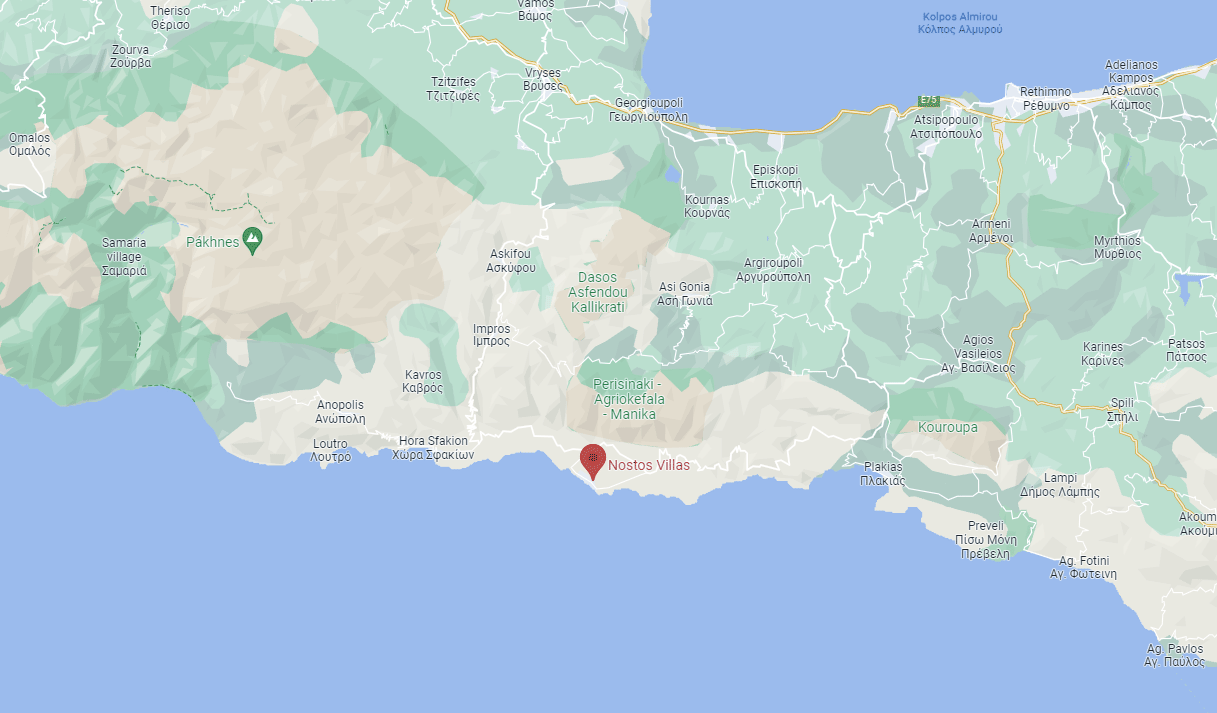Frangocastello

It took its name from the 14th century fortress that dominates this stretch of coastline. The fort was built next to the beach to assure protection against pirates and Cretan rebels. During the battle for Independence many Greek soldiers were slain within the fort and their martyrdom became legendary. Locals claim to this day that around 17 of May each year the ghosts of the slain soldiers appear in the misty dawn light and march from the castle to the sea. This is a phenomenon that intrigues visitors and locals over the ages!
The Frangokastello of today is a scattering of accommodation, a handful of tavernas and two or three minimarkets positioned alongside the beautiful beaches situated east and west of the old fort and beneath the region’s spectacular mountain backdrop.
People come here for many reasons the area is a delight for walkers with cozy coastal paths and challenging gorges; The light backfill of the place makes it ideal for those seeking pure relaxation; and for those who love to explore, heading west by boat or east by car it’s possible to discover the natural raw beauty that lies all along the south coast.
Access
Frangocastello is only two hours' drive from Heraklion airport and one and a half from Chania airport..
Access to Chora Sfakion will only take twenty minutes. From there you can get a boat to Loutro or Agia Roumeli, the exit of the famous Samaria gorge, or to Gavdos island, the southernmost point of Europe. From Sfakia to Anopolis, and walk to Lefka Ori (Pachnes) -the highest point of Crete.
In less than half an hour, you can reach Imbros gorge entrance or Kallikratis gorge.

Sightseeing
The Samaria Gorge in Crete is located in the southern part of the prefecture of Chania. With a length of 18 km, is probably the longest gorge in Europe after the canyon Verdi in France. It is a National Park of Greece since 1962 and is home to many endemic species of birds and animals, the most famous of which is the Cretan goat known as ibex.
The name comes from the abandoned village of Samaria, which in turn owes its name to the Church of Mary Osias. During the Ottoman rule was hiding rebels and the local population. The gorge is one of the major attractions of Crete drawing thousands of tourists who want to cross the walking route of 18 km from Smooth to Agia Roumeli.
Activities
The climate makes the area friendly all year around.
The nearest beach is a five-minute walk away and is almost private. There is a supermarket nearby and the village offers a great choice of tavernas servicen local products, mostly overlooking at the sea.
Beaches
Fragocastello Beach
A large sandy beach with shallow waters, ideal for children and adults. The landscape background with the old castle is unique.
Fragocastello is one of the most famous beaches of Crete , famous for the local Venetian castle on the lovely beach and the legendary Drosoulites . Located 13km east of Sfakia , 80km south of Chania , in a small valley southeast of the White Mountains.
The main beach of Fragokastelo is truly magnificent , with sand and turquoise shallow waters , ideal for children. It is well organized and generally very crowded. The only problem you may encounter is the frequent nuisance in the area south wind that carries sand with force . The area has several rooms, restaurants, cafes and shops, but the nearest cash machine mertiton and clinic located in Sfakia.
West of the main beach you will find great Vatalos beach , which is sandy and has local pebbles and rocks, ideal for mask. Walking east from the main beach for 10 minutes , you will find the stunning beach of Good Sand, famous for the big sand dunes and dunes.
Food - Leisure
The Cretan cuisine differs from other cuisines because it does not try to shuffle the flavors, as though using different materials to prepare daily food. Each material of them maintains its autonomy, maintains its identity and taste. Nothing comes to mask the taste of the other. One could say that all coexist harmoniously and ultimately reveal the delicate balances that characterize the cuisine of Crete .
What counts in Cretan Cooking is fantasy. The Cretan can eat every day greens or legumes, but almost never eats the same food. He finds a way to bring new qualities of materials and different flavors. This is one of the main features of the kitchen all Greek regions in Crete is perhaps more pronounced due to the variety of materials used ...
Historically, looking back to the roots of Cretan cuisine from antiquity to modern times will not find any substantial changes after few materials have been added to those used by the prehistoric inhabitants of the island.
Climate
The ideal months for hiking in Crete are April, May, and June as well as September and October. The conditions are quite ideal for sea bathing ( April only for the brave swimmers ) but the mountains can be no likelihood of storm and rain as well as cold weather.
Summer in Crete may prove too hot for hiking, however, the proposed routes are at lower elevations in coastal areas, valleys and canyons, where summer conditions proved wonderful because of the fresh sea air and the opportunity for a quick swim during hiking.
In the mountainous areas of Crete weather is always cooler.